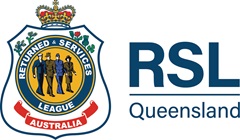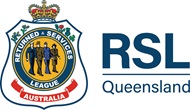
Lieutenant Colonel Henry Murray
22 June 2020- History & commemoration
- Veteran stories
One of Australia's most decorated soldiers.
Named “Australia’s most significant fighting officer” by historian Charles Bean, Lieutenant Colonel Henry Murray had an illustrious military career that earned him a Victoria Cross during WWI, before he retired into a life of relative obscurity on a farm in Queensland.
This story of a Victorian Cross recipient must first be told as a tale of two men who operated a Maxim gun at Gallipoli with such distinction that they were both awarded the Distinguished Conduct Medal for service. Henry Murray, commonly known as ‘Harry’, and Percy Black fought on while wounded, operating a machine-gun that became so bullet-ridden it had to be replaced.
Historian Charles Bean wrote of them as “men of no ordinary determination”. Each would be commissioned before leaving Gallipoli and proceed to higher rank and reputation.
Although normally quiet and self-effacing, Harry was later given the name of “Mad Harry” for his insistence on leading his men from the front. At a location near Gueudecourt on the Western Front, his outstanding bravery and leadership over many hours would bring him the nation’s supreme award – the Victoria Cross.
By the end of the war he would be Australia’s most highly decorated soldier, with the rank of Lieutenant Colonel.
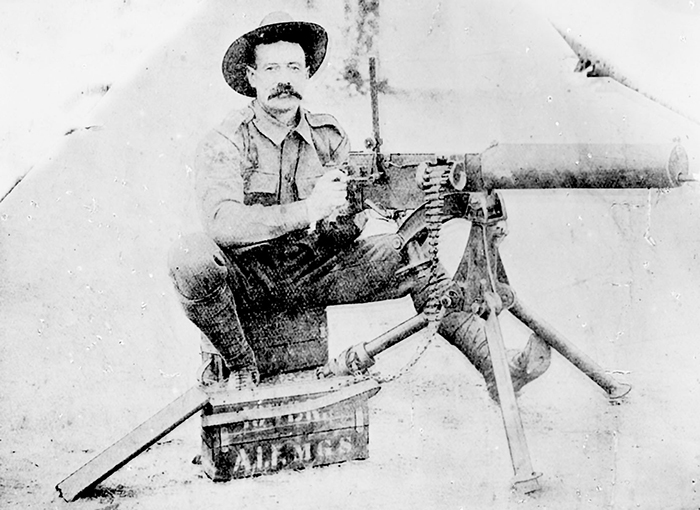
Henry (Harry) Murray and Percy Black (pictured) were described by their drill instructor as the best machine gunners he had ever seen. (AWM: J00385)
EXPERT MACHINE GUNNERS
Harry and Black enlisted in Western Australia in October 1914. They both came from timber-getting and mining backgrounds. They could strip a Maxim gun in 12.5 seconds (the textbook allowed 45) and their West Australian drill instructor believed they were the best machine gunners he had ever seen.
Black was the gun’s number one and Murray was number two. Harry had an exceptional ability to read topography, which enabled their gun to be placed to maximum advantage.
In Egypt, following the Gallipoli withdrawal, Black would remain with the 16th Battalion AIF while Murray was assigned to the 13th. Both units were part of Monash’s 4th Brigade.
Moving to the Western Front as company commanders, the two men never failed an assignment. In some cases, withdrawals were necessary because of failures in the supply of reinforcements.
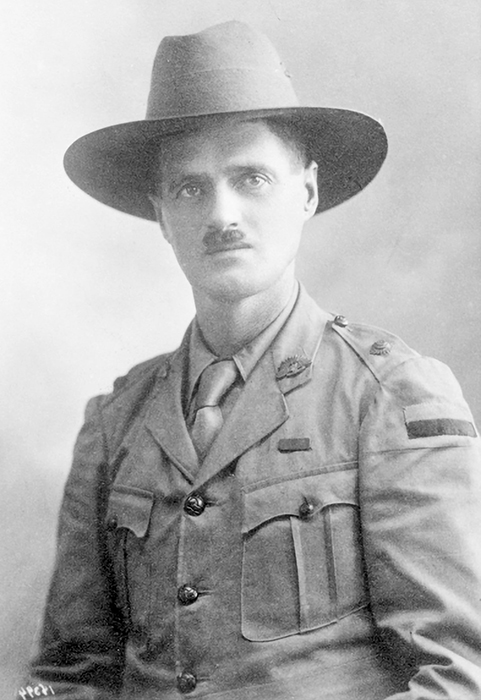
Studio portrait of Second Lieutenant Henry William (Harry) Murray DCM, 13th Battalion. Murray was later awarded the VC, DSO and Bar, and Croix de Guerre, ending the war as a Lieutenant Colonel. (AWM:P01465.002)
THE MEN’S STORIES DIVERGE
At this point we shall focus on the career of Harry Murray, who, at the pinnacle of his career, was awarded the Empire’s greatest award for bravery. Sadly, his friend Black died on the wire at a major assault on the Hindenburg Line at Bullecourt in April 1917.
Harry’s Western Front story begins at the Somme. On 29 August 1916, as commander of “A” Company, he captured his objective at nearby Mouquet Farm under heavy fire. He did so with less than 100 men, and held it against four counter attacks, before having to withdraw.
He fought on wounded and – in acknowledgement of his sterling leadership – earned the award of Distinguished Service Order. He was then evacuated to England, but returned to France on 19 October 1916, where he continued with patrols and trench raids.
In January 1917, he was mentioned in despatches and by the middle of that month his battalion was located at Gueudecourt.
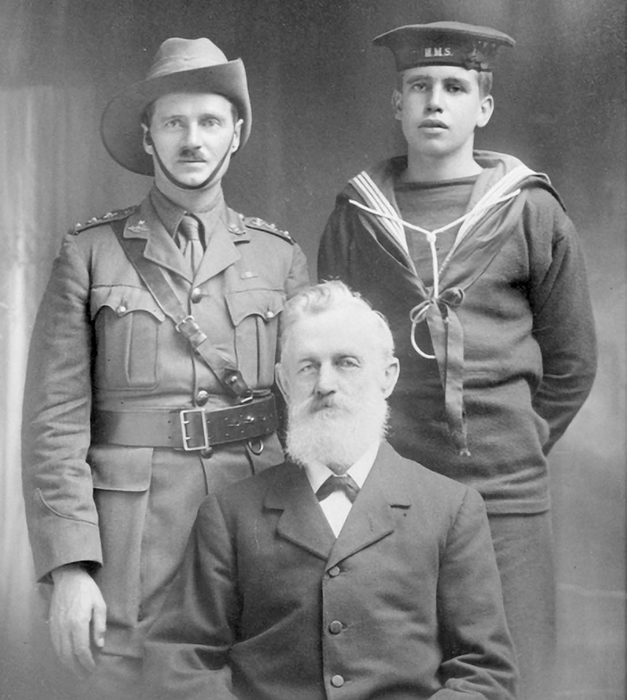
Captain Murray, left, with his nephew Keith Murray Adams RN and uncle Captain William Thomas Littler. (AWM: P01465.003)
NIGHT OF DESTINY
On 4-5 February, in a landscape of frozen snow, his company was instructed to take opposing enemy positions at a location known as Stormy Trench. This would be his night of destiny.
After stiff resistance, his company found itself in a German trench where they established a blockade, and successfully resisted three counter attacks. With some artillery support and a brilliant bombing attack by Murray with 20 men, the German trench was finally secured.
When the operation concluded at 3am, Murray had demonstrated outstanding bravery and leadership. He had provided encouragement and consolation to his men and had personally retrieved wounded from no man’s land. Of the 140 men who began the attack, only 48 survived.
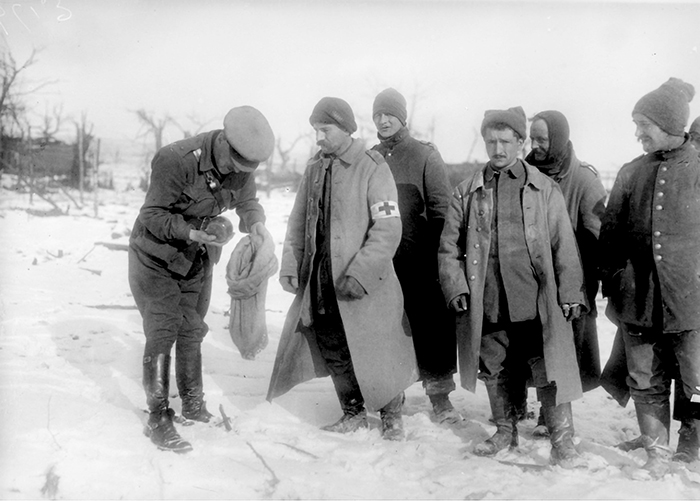
German prisoners captured by the 13th Battalion at Stormy Trench being searched by an Australian Intelligence Officer. (AWM:E00179)
VICTORIA CROSS AWARDED
On March 1917, the War Office announced: “His Majesty the King has been graciously pleased to approve the award of the Victoria Cross to the undermentioned Officer and Non- Commissioned Officer: Capt. Henry William Murray, DSO, Aus. infy.”
In April 1917, Murray’s 13th Battalion attacked the Hindenburg Line at Bullecourt (where Percy Black was to lose his life), and his company seized a section of German trench that could not be held because of lack of support.
Notwithstanding, Murray was later informed by General Birdwood that had the overall assault been successful, he would have received a Bar to his Victoria Cross. In lieu of this he was awarded a Bar to his Distinguished Service Order.
Captain Murray was elevated to the rank of Major on 12 July and the 13th Battalion saw actions at Messines, Ploegsteert Wood, Menin Road, Polygon Wood, Broodseinde, Poelcapelle and Passchendaele. Murray as ‘mentioned in despatches’ for his actions at Passchendaele and shortly after he became second-in-command of his battalion.
With elevation to the rank of Lieutenant Colonel on 15 March 1918, Murray assumed command of the 4th Machine Gun Battalion, which he directed with considerable skill in attacks at Hamel and Amiens. After a stint as a liaison officer with the 27th Division of the United States 11 Corps, he was recommended for that nation’s Distinguished Service Medal.
This was Murray’s last action of the war. After the conflict, he was awarded the French Croix de Guerre, he was made a Companion of the Order of St Michael and St George for his command of the 4th Machine Gun Battalion, and received a further ‘mention in despatches’, an award that was given to him four times during his military career.
A HERO’S WELCOME BACK HOME
Murray’s war was now at an end – but not his reputation for bravery and as an incomparable leader of men. He arrived in Fremantle in December 1919 with Generals Birdwood and Monash, to a tumultuous welcome, where he was carried shoulder high to the location of a formal reception.
He retired into a life of comparative obscurity. He married, divorced, remarried and purchased a grazing property in Queensland in 1928.
While he didn’t attend ANZAC Day marches, he did write a series of articles about his wartime experiences for Reveille, the journal of the Returned Sailor’s Soldier’s Airmen’s Imperial League of Australia (RSSAILA).
On one occasion he re-visited London for the Centenary of the Victoria Cross. On that trip, he also travelled around Europe, but never revisited the WWI battlefields where Charles Bean had named him as “Australia’s most significant fighting officer”.
When WWII broke out, he was given command of a CMF battalion, but was replaced by General Blamey when the unit transferred to AIF status. Not deterred, he formed a VDC group of experienced local bushmen in Queensland, retaining his rank of Lieutenant Colonel.
As in WWI, he commanded the affection and respect of all who served with him. His unit was popularly known as ‘Murray’s Cowboys’ and would have been an exceptional guerrilla force had it ever gone into action.
AN UNLIKELY END
In 1966, when his car rolled off the road on a trip to the Gold Coast, the shock to his heart was believed to have caused his death. The old soldier who faced mortality so many times with grenade and revolver in hand in WWI, had succumbed to a comparatively minor car accident.
Such is Murray’s fame that history has not forgotten him. On 24 February 2006, 40 years after his death, Governor-General Michael Jeffery unveiled a statue to the memory of Lieutenant Colonel Henry Murray VC, at Evandale, Tasmania – the hero’s birthplace.
The combined medals of Australia’s most decorated soldier, by arrangement with his family, are displayed at the Australian War Memorial.
Related News
Loading
